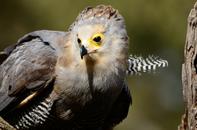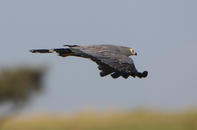Name
African Marsh Harrier - Circus ranivorus
African Marsh Harrier Appearance
The African marsh harrier has mostly brown plumage with pale streaks on the head, breast and forewings. The thighs and belly are a rufous colour. This harrier has yellow eyes and legs. The tail and flight feathers are barred, which can be seen in flight. The male differs from the female with being around 30% smaller and they have more light coloured flight feathers.
Diet
The African marsh harrier feeds mostly on small rodents, small birds, fish, insects and frogs. This harrier has been seen feeding on carrion, like the remains of a fish eagle kill, fish and flamingos.
African Marsh Harrier Breeding
The African marsh harrier is monogamous and builds a nest in a reed bed, well above the water. Two to four eggs are laid. The eggs are incubated for around 32 days and the chicks fledge around 40 day later. Incubation starts with the first egg, leading to a size difference between the chick. This often leads to the smallest chick not surviving due to starvation.
African Marsh Harrier Behaviour
The African marsh harrier has been recorded covering up to 200 km in a day, while foraging during the breeding season. This harrier hunts in typical harrier style, flying low over the ground. During the breeding season, they can be seen in pairs, but outside of the breeding season they are normally singular.
Threats
The African marsh harrier is classed as vulnerable in South Africa.
African Marsh Harrier Distribution and Habitat
The African marsh harrier is normally found in areas that have more than 300 mm of annual rain. The preferred habitat is inland and coastal wetlands and adjacent moist grasslands. The African marsh harrier is found along the coast from the West Coast National Park to Kozi Bay and across the eastern parts of South Africa.

